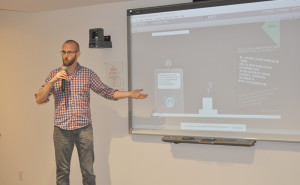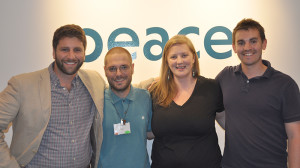#PeacehackDC generates new tech tools to counter violent extremism
By Jillian SlutzkerSeptember 28, 2015
For 36 hours, nearly 20 peacebuilding experts and technologists huddled around laptops in a rush to hammer out new games, applications and tools to counter violent extremism. Hosted by Creative Associates International in partnership with International Alert in Sept. 2015, #PeacehackDC joined a global #Peacehack effort to develop tech solutions to promote peace and mitigate violent conflict. Get an inside view of the process behind “hacking” for peace.
For 36 hours, nearly 20 peacebuilding experts and technologists huddled around laptops in a rush to hammer out new games, applications and tech tools to counter violent extremism as part of #PeacehackDC.
Hosted by Creative Associates International in partnership with International Alert, #PeacehackDC joined concurrent hackathons in Barcelona, Beirut and London Sept. 25 and 26 in a global effort to develop technology solutions to promote peace and mitigate violent conflict. A similar event occurred in Colombo a week earlier.
Together, the hackathons tackled challenges from the global refugee and migrant crisis to countering the influence of extremists groups like ISIS, which garners more than 50,000 pro-ISIS tweets daily.
“I think one of the biggest opportunities for technology and countering violent extremism is the fact that technology, mass media and other tools are already widely used by people who are extremists,” says Ayan Kishore, Senior Associate in Technology for Development at Creative.
Kishore says that by using existing tools to strategically dispatch peaceful messages, “we can actually take back this media space that is being used more effectively by those who are interested in conflict and not in peace.”
Tackling tough challenges
Prior to #PeacehackDC, participants used a shared online “hackpad” to review key datasets, brainstorm ideas and read about the six challenges they would try to address—from recruitment into violent extremists groups to countering violent messaging and rehabilitating former foreign fighters.
The rise in access to technology and advances in the field have expanded the toolbox for peacebuilders. Technology can go where traditional on-the-ground programming cannot always venture, explains Jo Robinson, Program Officer at International Alert.
“I think technology has a huge role to play in addressing all of those challenges and I think it can reach people who feel marginalized, who feel vulnerable, in a way that traditional programs haven’t been able to do in some cases,” says Robinson.
Getting smart about design & context

After an opening panel of experts on countering violent extremism and strategic communications, hackathon participants jumped head-on into the challenges—filling in notebooks with concepts, prototype designs and information about the contributing factors to violent extremism.
Understanding context is critical for designing tools that will actually reach the right groups and resonate, says Paul Turner, Senior Conflict Advisor at Creative.
“Tech tools have to be culturally sensitive and grounded in the local dynamics of what’s happening in order to be effective,” says Turner.
Taking context into account, in four groups’ hackathon participants developed four unique interventions:
- Global Peace Hub, a platform to connect peacebuilders worldwide;
- Ask Me Anything, a tool using artificial intelligence to understand why youth in the West are motivated to join violent extremist groups;
- Disrupt, a game that generates positive, pro-peace social media messages to counter violent extremist messaging; and
- Vallation, an early warning system to track hate speech toward particular groups and trigger a response system.
At the end of #PeacehackDC, each team would present their innovations to judges for advice on how to improve their prototypes and potentially move it forward.
Taking a technological idea from design to fruition in just 36 hours is no easy task, but the chance to make something tangible is not to be missed, according to #PeacehackDC participant Derek Caelin, a specialist at The PeaceTech Lab.
“So often in the peacebuilding community we are confronted with difficult problems where we have to think, we have to write, we have to communicate. And all these are absolutely necessary,” says Caelin, who had the idea for the game Disrupt prior to the event. “But the fun thing also is creating something… to share with your community, start a conversation and initiate a learning process, not just for you but for others.”
Teams generated new ideas but also used existing tools, from the social data analysis platform Crimson Hexagon to GDELT, self-described as “the largest, most comprehensive, and highest resolution open database of human society ever created.”
As a longtime digital communications and social media strategist, #PeacehackDC mentor Alan Rosenblatt of Turner4D has seen many innovations, but says the ingenuity at #PeacehackDC was commendable.
“I’ve been really impressed with the way people are thinking creatively about some really elaborate data sets and how to incorporate them into apps,” says Rosenblatt. “All of the ideas that have been presented are great. Several of them would be game changers.”
Online & offline connections
In the throes of hacking, #PeacehackDC and three other global #peacehacks connected on a Google Hangout to share ideas.
DC Peacehacker Amy Yeung, a research analyst at software company, Socrata, says the online chat was a way to bring like-minded people together.
“I think the connection there is that everyone wants to do good. They want to get rid of violent extremism or just violence in general,” says Yeung.
Within the room, critical connections were also made between the technology community and peacebuilding specialists.
“There are a lot of peacebuilders out there who are experts in their particular field but not necessarily aware of the technologies that are out there that help them make better decisions, analyze data in a more effective way, or communicate with a broader audience,” says Caelin.
The outcome of bringing the two groups together, Caelin says, is a “much more effective peacebuilding program than if either of these actors were operating separately.”
Winning innovations to get off ground

With their ideas finalized and prototypes complete, #PeacehackDC teams presented their pitches to four judges—experts in open data, gaming, counterterrorism, mapping, online hate speech and journalism.
Judges assessed the four projects on nine criteria, ranging from innovation to market viability to the team’s expertise and teamwork.
Winning 300 hours of consulting services from Development Solutions Organization was Disrupt, the game that uses entertainment incentives for people to create and amplify the positive messages of local peacebuilders.
The team behind Vallation, the early warning system to track hate speech toward particular groups and trigger a response system, was awarded $500, tickets to the 2016 Build Peace- Peace through Technology conference in Zurich, and the opportunity to pilot the tool with a future Creative-implemented project.
“I think it’ a really exciting chance,” says Kate Seaman, Senior Fellow at the Nexus Fund and member of the Vallation team.
Seaman say the team will take the judges’ advice into account as they move forward with Creative into the pilot phase to “build off of existing projects using already existing analysis tools, but filing in gaps in a practical way that could be used by local peacebuilders on the ground.”
For 36 hours, nearly 20 peacebuilding experts and technologists huddled around laptops in a rush to hammer out new games, applications and tools to counter violent extremism. Hosted by Creative Associates International in partnership with International Alert in Sept. 2015, #PeacehackDC joined a global #Peacehack effort to develop tech solutions to promote peace and mitigate violent conflict. Get an inside view of the process behind “hacking” for peace.


